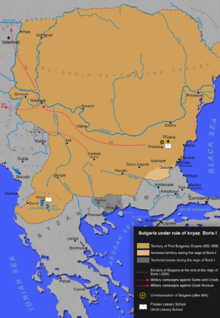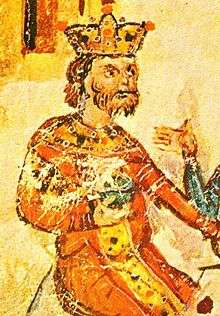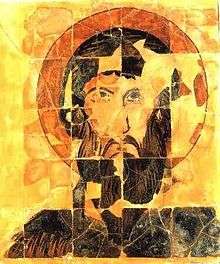Christianization of Bulgaria
 Baptism of the Preslav court by Nikolai Pavlovich (1835-1894) - date of completion unknown | |
| Date | 864 AD |
|---|---|
| Location | Began spreading from Preslav |
| Outcome | Bulgaria converts to Christianity |
The Christianization of Bulgaria - the process by which 9th-century medieval Bulgaria converted to Christianity - reflected the shifting political alliances of Tsar Boris I of Bulgaria (ruled 852-889) with the kingdom of the East Franks and with the Byzantine Empire, as well as his reception by the Pope. Because of Bulgaria's strategic position, the churches of both Rome and Constantinople each wanted Bulgaria in their sphere of influence. They regarded Christianization as a means of integrating Slavs into their region. After some overtures to each side, the knyaz adopted Christianity from Constantinople in 870. As a result, he achieved his goal of gaining an independent Bulgarian national church and having an archbishop appointed to head it.
Background

When Tsar Boris began his reign in 852, the international situation was very complicated. The conflict with the Byzantine Empire for domination over the Slavic tribes in modern-day Macedonia and Thrace was still far from being resolved. In the middle Danube region, Bulgaria's interests crossed with those of the emerging kingdom of the East Franks and the principality of Great Moravia. It was about that period when Croatia emerged on the international scene, carrying its own ambitions and demands for territories in the region.
On a larger scale, the tensions between Constantinople and Rome were tightening. Both centres were competing to lead the Christianization that would integrate the Slavs in South and Central Europe. The Bulgarian Empire and the Kingdom of the East Franks had established diplomatic relations as soon as the 20s and 30s of the 9th century. In 852, at the beginning of the reign of Knyaz Boris, a Bulgarian embassy was sent to Mainz to tell Louis II of the change in Pliska, the Bulgarian capital. Most probably the embassy also worked to renew the Bulgarian-German alliance.
Initial setbacks
| Part of a series on |
| Eastern Christianity |
|---|
 |
|
Liturgy and worship |
|
Some time later, Tsar Boris concluded an alliance with Rastislav of Moravia (846–870) instigated by the King of the West Franks, Charles the Bald (840–877). The German Kingdom responded by attacking and defeating Bulgaria, forcing Knyaz Boris to re-establish an alliance with the German king directed against Great Moravia, a Byzantine ally. The situation held great risk for the Bulgarian state. War finally broke out between 855-856. The Empire wanted to regain control over some fortresses on the Diagonal Road (Via Diagonalis or Via Militaris) that went from Constantinople, through Philippopolis (Plovdiv), to Naissus (Niš) and Singidunum (Belgrade). The Byzantine Empire was victorious and reconquered a number of cities, with Philippopolis being among them.[1]
This renewed alliance threatened Great Moravia, which sought help from Byzantium (862–863). This was at the same time when a Byzantine mission to Great Moravia was taking place. Cyril and his brother Methodius intended to draw Great Moravia closer to Constantinople circle and strengthen the Byzantine influence there.
Tsar Boris was more interested in that Cyril and Methodius brought him the first Slavonic alphabet they created for Knyaz Rostislav. Bulgaria wanted to implement a Slavonic alphabet as well as a means to stop the cultural influence of the Byzantine Empire.
In the last months of 863, the Byzantines attacked Bulgaria again probably because they learned that Boris told the German king that he was willing accept Christianity and Byzantium had to forestall him from taking up Christianity from Rome. A Rome-dependent Bulgaria in the hinterland of Constantinople was a threat to the Byzantine Empire's immediate interests.
Byzantine demand

Byzantium did not demand territories but the conversion to Eastern Christianity of Bulgarian representatives and leaders, followed by conversion by the rest of the Bulgarian people. Such a demand would be unacceptable in other circumstances.
The two sides concluded a "deep peace" for a 30-year period. In the late autumn of 863, a mission from the Patriarch of Constantinople Photios came to Pliska and converted the tsar, his family and high-ranking dignitaries. They were all baptized as Christians.
Reasons for the Christianization
Following the conquests of Tsar Krum of Bulgaria at the beginning of the 9th century, Bulgaria became an important regional power in Southeastern Europe. Its future development was connected with the Byzantine and East Frankish empires. Since both of these states were Christian, the Pagan Bulgaria remained more or less in isolation, unable to interact on even grounds, neither culturally nor religiously.
After the conversion of the Saxons, most of Europe was Christian. The preservation of paganism among the Bulgars and the Slavs (the two ethnic groups that formed the Bulgarian people) brought another disadvantage — the two ethnic groups' unification was hampered by their different religious beliefs. Lastly, Christianity had its roots in the Bulgarian lands prior to the formation of the Bulgarian state.
Reaction

Louis, King of East Francia, was not satisfied with Boris's plan, but he did not carry his fears on to open conflict.
As Byzantine missions converted the Bulgarians, their forces encouraged the people to destroy the Pagan holy places. Conservative Bulgarian aristocratic circles opposed such destruction, as they had led the spiritual rituals. In 865, malcontents from all ten administrative regions (komitats) revolted against Boris (now titled Knyaz), accusing him of giving them "a bad law". The rebels moved toward the capital intending to capture and kill the knyaz, and to restore the old religion.
All that is known is that Knyaz Boris gathered people loyal to him and suppressed the revolt. He ordered the execution of 52[2] boyars who were leaders in the revolt, "along with their whole families". The commonfolk who "wished to do penance" were allowed to go without harm.
Until the end of his life, Knyaz Boris was haunted by guilt about the harshness of his measures and the moral price of his decision in 865. In his later correspondence with Pope Nicholas I, the knyaz asked whether his actions had crossed the borders of Christian humility. The pope answered:
| “ | ... You have sinned rather because of zeal and lack of knowledge, than because of other vice. You receive forgiveness and grace and the benevolence of Christ, since penance has followed on your behalf. | ” |
Critics may disagree with the Pope's assessment. Historians believe the knyaz executed almost half the Bulgarian aristocracy to end the religious and political conflict. His aristocratic opponents had feared that the Byzantine Empire would spread its influence through Christianity and destroy Bulgaria. At this time during the Middle Ages, Bulgarians considered "Christians" as equivalent to their traditional competitors the "Byzantines", or "Greeks", as they were most often called. Many Bulgarians thought that along with Christianity, they would be forced to accept the Byzantine way of life and morals.
Choice between Rome and Constantinople
Knyaz Boris realized that the Christianization of his subjects would result in greater Byzantine influence. The liturgy was performed in the Greek language, and the newly established Bulgarian Church was subordinate to the Church of Constantinople. The revolt against the new religion prompted the Knyaz to ask Constantinople to allow the Bulgarian Church independent status.
Prior to the middle of the 9th century, in the practice of the formally united Church, there were no precedents for creating national churches among newly converted peoples. Bulgaria created this precedent and set the example for others to follow.
When Constantinople refused to grant the Bulgarian Church independence, Knyaz Boris turned to the Pope. At the end of August 866, a Bulgarian mission led by the kavhan Peter arrived in Rome, carrying a list of 115 questions from Knyaz Boris. These had to do with the Christian way of life of the newly converted Bulgarians and the potential organization of a future Bulgarian Church under Rome's jurisdiction. On 13 November 866, the Bulgarian knyaz received the Pope's 106 answers. Formosa from Portua and Paul of Populon led the Pope's mission. At the same time, the Pope sent other emissaries to Constantinople.
When the Roman clerical mission arrived, Knyaz was sufficiently satisfied with Rome's response that he ordered the Byzantine mission to leave Bulgaria. This was viewed as an official change of Bulgarian orientation from Constantinople to Rome. Seeing Rome's emissaries there, the German mission also left Bulgaria, satisfied that Bulgaria will be in the Roman diocese.
Emperor Michael III was displeased by Bulgaria's banishment of Byzantium's clergy. In a letter to Knyaz Boris, the Byzantine emperor expressed his disapproval of Bulgaria's religious reorientation by using offensive language against the Roman Church. The old rivalry between the two branches of Christianity burned with new power. In less than two years, Bulgaria's name became widely known in Western Europe.
In Constantinople, people nervously watched the events taking place in Bulgaria. They believed a pro-Roman Bulgaria threatened Constantinople's immediate interests. A religious council was held in the summer of 867 in the Byzantine capital, during which clerics criticized the Roman Church's actions of recruiting Bulgaria. Pope Nicholas I was anathematized.
Without losing time, Knyaz Boris asked the Pope to appoint Formosa of Portua as Bulgarian Archbishop. The Pope refused, probably for some personal reasons, because the official response - that Formosa already had an eparchy - was untrue.
The Pope ordered new leaders, Dominic of Trivena and Grimwald of Polimarthia, of a mission to be sent to Bulgaria. Soon after, Nicolas died. His successor, Pope Adrian II (867-872), also failed to respond to Knyaz Boris' request for appointment of a Bulgarian archbishop.
The Knyaz proposed another candidate for Bulgarian archbishop, but the Pope refused. Instead, he received a cleric named Silvester, a man so low in the hierarchy that was not authorized to carry out liturgy by himself. After he had a three-day stay in Pliska, the Bulgarians sent him back to Rome accompanied by emissaries carrying a letter of complaint by Knyaz Boris. The Knyaz perceived Rome's refusals of his request and delays as an insult and a sign of the Pope's unwillingness to coordinate selection with him of a Bulgarian archbishop.
As a result, Boris began negotiations again with Constantinople, with whom he expected more cooperation than shown in the past. But, on 23 September 867, Emperor Michael III was killed by his close acquaintance Basil, who established the Macedonian dynasty that ruled the Empire until 1057. Patriarch Photius was replaced by his ideological rival Ignatius (847-858; 867-877). The new rulers of the Byzantine Empire quickly lessened tensions between Constantinople and Rome. Pope Adrian II needed the help of Basil I against the Arabs' attacks in Southern Italy. On the other hand, Byzantium anticipated the Pope's support for Patriarch Ignatius.
Result
As a result of the leaders' agreements, a Church Council was held in Constantinople. After the end of the official conferences, on 28 February 870 Bulgarian emissaries arrived in Constantinople, sent by the Knyaz and led by the Ichirguboil (the first councilor of the Knyaz) Stasis, the Kan-Bogatur (high-ranking aristocrat) Sondoke, the Kan-Tarkan (high-ranking military commander) among others.
Few people suspected the real purpose of these emissaries. On 4 March Emperor Basil I closed the Council with a celebration at the Emperor's palace. In attendance was the Bulgarian Kavkan (roughly a vicekhan or viceknyaz) Peter. After he greeted the representatives of the Roman and Byzantine Churches (the Roman being first), Kavkan Peter asked under whose jurisdiction the Bulgarian Church should fall. The Roman representatives were not prepared to discuss this matter.
There appeared to have been a secret agreement between the Byzantine Patriarch, the Emperor and the Bulgarian emissaries. The Orthodox fathers immediately asked the Bulgarians whose clergy they had found when they came to the lands which they now ruled. They answered "Greek". The Orthodox fathers declared that the right to oversee the Bulgarian Church belonged only to the Constantinople Mother Church, which had held jurisdiction on these lands in the past.
The protests of the Pope's emissaries were not taken into account. With the approval of the Knyaz and the Fathers of the Council, the Bulgarian Church was declared an Archbishopric. The Archbishop was to be elected among the bishops with the approval of the Knyaz. The creation of an independent Bulgarian Archbishopric was unprecedented. Usually, independent churches were those founded by apostles or apostles' students. For a long period, Rome had been challenging Constantinople's claim of equality to Rome on the grounds that the Church of Constantinople had not been founded by an apostle of Christ.
Just six years after his conversion, the Orthodox Church granted Knyaz Boris a national independent church and a high-ranking supreme representative (the Archbishop). Over the next 10 years, Pope Adrian II and his successors made desperate attempts to regain their influence in Bulgaria and to persuade Knyaz Boris to leave Constantinople's sphere.
The foundations of the Bulgarian national Church had been set. The next stage was the implementation of Cyrillic and the Old Bulgarian language as the official language of the Bulgarian Church and State in 893 AD during the Council of Preslav. Such nationalization of the church and liturgy was exceptional and not at all part of the practice of other European Christians.
See also
| Wikimedia Commons has media related to Christianization of Bulgaria. |
- Saints Cyril and Methodius
- Cyrillic script
- Boris I of Bulgaria
- Glagolitic alphabet
- Ballshi inscription
Notes
- ↑ Gjuzelev, p. 130
- ↑ http://promacedonia.org/vz1b/vz1b_3_2.html
References
- Gjuzelev, V., (1988) Medieval Bulgaria, Byzantine Empire, Black Sea, Venice, Genoa (Centre culturel du monde byzantin). Verlag Baier.
Bibliography
- Sullivan, R.E., (1994) Christian Missionary Activity in the Early Middle Ages (Variorum Collected Studies Series). Ashgate Publishing Limited, ISBN 0-86078-402-9.
- Vlasto, A.P., (1970) The Entry of the Slavs into Christendom: an Introduction to the Medieval History of the Slavs. Cambridge University Press.






